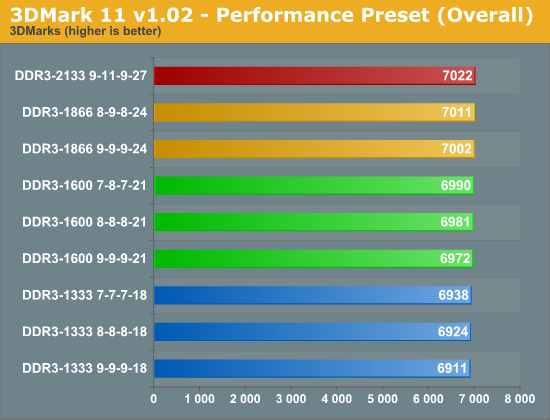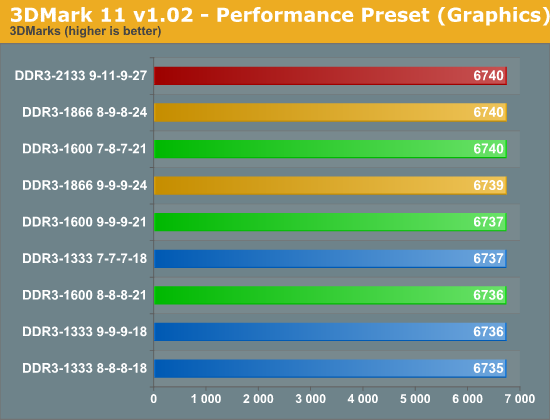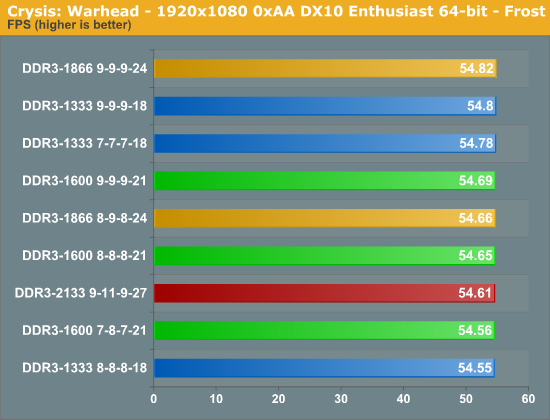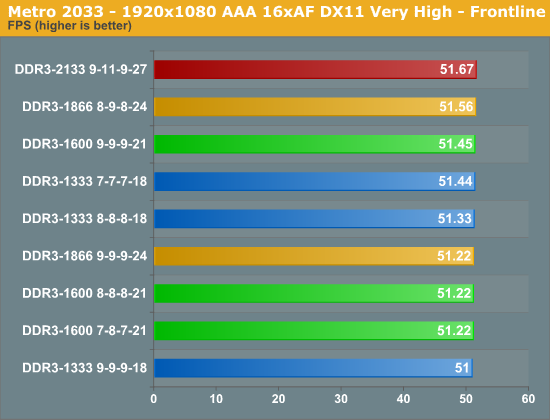Sandy Bridge Memory Scaling: Choosing the Best DDR3
by Jared Bell on July 25, 2011 1:55 AM EST3DMark 11
We're going to start the graphics benchmarks with the synthetic 3DMark test. The latest version, 3DMark 11, is still very GPU dependent. However, it does include a CPU Physics test and a combined graphics/physics test for simulating those types of loads. We’ll use the overall score with the three subtests to see if we can find any areas where memory performance makes a noticeable difference.




The overall score, which is heavily based on the graphics tests, shows a mere ~1% change across the board. When you get to the graphics test, you can see that the faster memory makes absolutely no difference at all. It's not until we get to the physics test where we see some improvement from increasing the memory speed. We get performance boost of up to 11% when going from DDR3-133 to DDR3-2133. The combined test entails the rendering of a 3D scene with the GPU while performing physics tasks on the CPU. Here again, were see a very small 2% increase in performance from the slowest to the fastest.
Crysis and Metro 2033
Based on 3DMark 11, then, we’d expect most games to show very little improvement from upgrading your memory, but we ran several gaming benchmarks just to be sure. I decided to combine the analysis for Crysis: Warhead and Metro 2033 due to the virtually non-existent differences observed during these tests. Crysis: Warhead was the previous king of the hill when it came to bringing video cards to their knees. The newer kid on the block, Metro 2033, has somewhat taken over that throne. Just how do they react to the various memory configurations we're testing today?
It's worth noting that the settings used here are the settings that I would actually play these games at: 1920x1080 with most of the high quality features enabled. Frame rates are well above 30, so definitely playable, though they’re below 60 so some would say they’re not perfectly smooth. Regardless, unless you play at settings where your GPU isn’t the primary bottleneck, you should see similar scaling from memory performance.


The results weren't very stimulating, were they? Just as expected, gaming with faster memory just doesn't make any notable difference. I could have potentially lowered the resolution and settings in an attempt to produce some sort of difference, but I felt that testing these games at the settings they're most likely to be played at was far more enlightening. If you want better gaming performance, the GPU is the best component to upgrade—no news there.










76 Comments
View All Comments
dfjgkheu - Tuesday, July 26, 2011 - link
believe you will love it.====( www )( bestniceshoes)( c o m ) ====
The website whol esale for many kinds of fashion shoes,
like the ni ke, jor dan, pra da, also including the jea ns,shirts,bags,hat and the decorations.
All the products are free ship ping, and the the price is competitive,
and also can accept the pay pal payment.
,after the payment, can ship within short time
vailr - Monday, July 25, 2011 - link
No discussion of differing voltages?A quick check for DDR3 at Newegg shows:
G.SKILL ECO Series 4GB (2 x 2GB) 240-Pin DDR3 SDRAM DDR3 1600
@ 1.35 volts & Cas Latency: 7
vs.
G.SKILL Ripjaws X Series 4GB (2 x 2GB) 240-Pin DDR3 SDRAM DDR3 1600
@ 1.50 volts & Cas Latency: 6
A more thorough consideration of these two DDR3 modules might be interesting.
For virtually the same money, aren't most people going to seek out DDR3 with the lowest possible CAS latency number, and also combined with the lowest possible voltage design?
I know that: I wouldn't consider buying any DDR3 memory modules with a (nominal) CAS latency higher than 7.
JarredWalton - Monday, July 25, 2011 - link
Just as we didn't test with ten different modules (for ease of testing), we didn't use different voltage memory. Whether your RAM is 1.5V or 1.35V, at the same timings and speed the performance should be identical (less than a 0.5% difference). And we did look at the effect of lower latency RAM; sure, at the same price buy lower latency and higher bandwidth RAM, but prices aren't the same, particularly on 2x4GB kits.Tchamber - Monday, July 25, 2011 - link
I'd like to see how these tests stack up against the tripple channel nehalem i7's.duploxxx - Monday, July 25, 2011 - link
compare with what an EOL platform? it was alreay known that there is no added value with memory speed testing on these systems, just like the previous gen., 1366 is dead testing has been done in the pastThis test just showed that it is a lot of wasted money and time investigated in this.
They better take the time and investigate further into Liano memory speed, something that really does scale with memory.
Finally - Monday, July 25, 2011 - link
It's already done, see Computerbase...JarredWalton - Monday, July 25, 2011 - link
We've done it as well for graphics applications:http://www.anandtech.com/show/4476/amd-a83850-revi...
We haven't done the application testing with different DDR3 on Llano, however.
banwell - Monday, July 25, 2011 - link
You can also get a nice 'free' bump in performance at 1600 by switching to 1T. Something the better quality memory will be able to do easily.AssBall - Monday, July 25, 2011 - link
I'm not sure why they didn't test 1T . It is a memory scaling article after all. Anyway TechReport did and their conclusions are about the same, I.E. unless you are overclocking and running synthetic benchmarks, it doesn't really matter.compudaze - Monday, July 25, 2011 - link
Lowering the command rate from 2T to 1T at DDR3-1600 doesn't necessarily mean you can do the same at DDR3-2133. Not all memory modules, CPU's and motherboards are creased equal. Testing all configurations at 2T kept the results comparable.